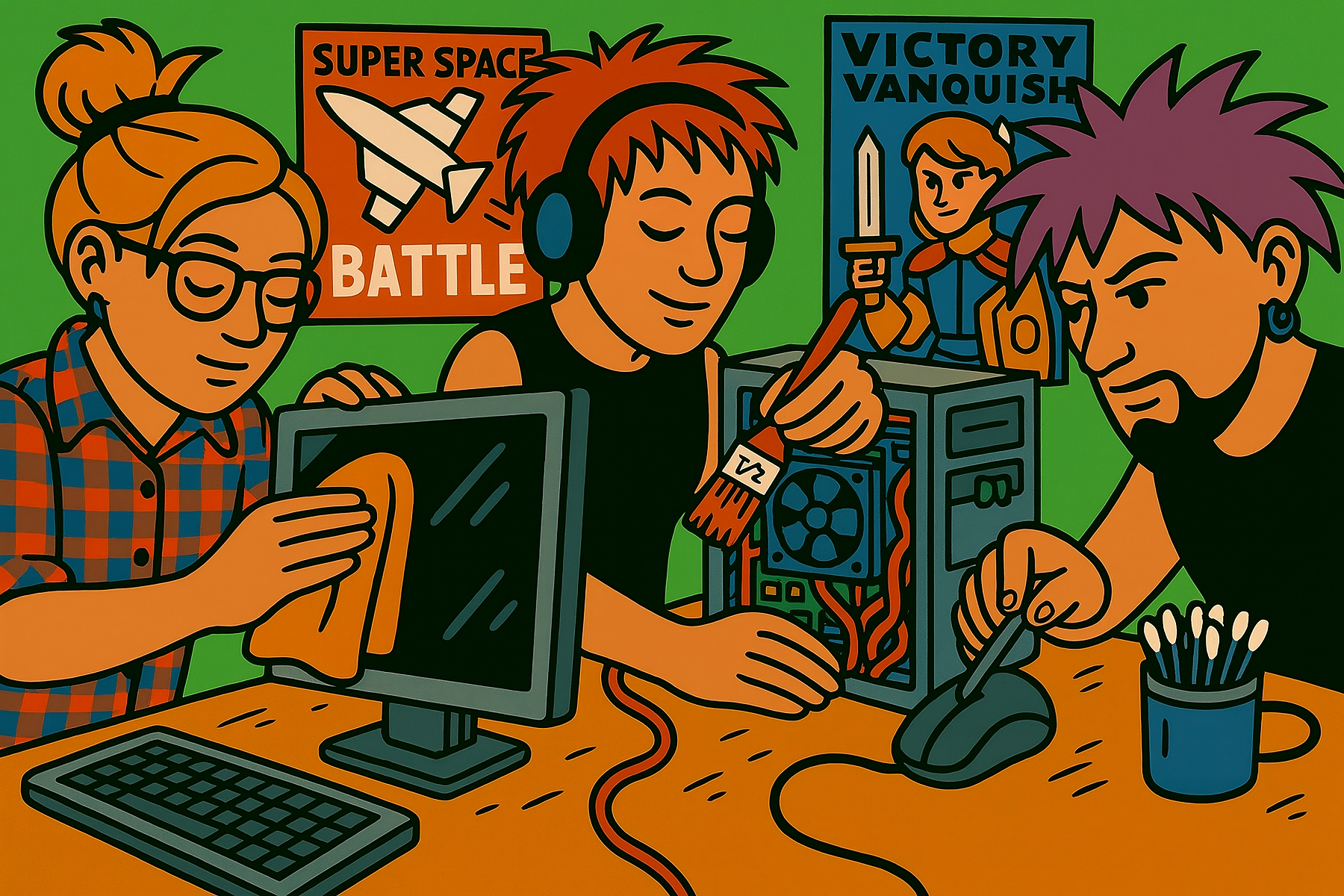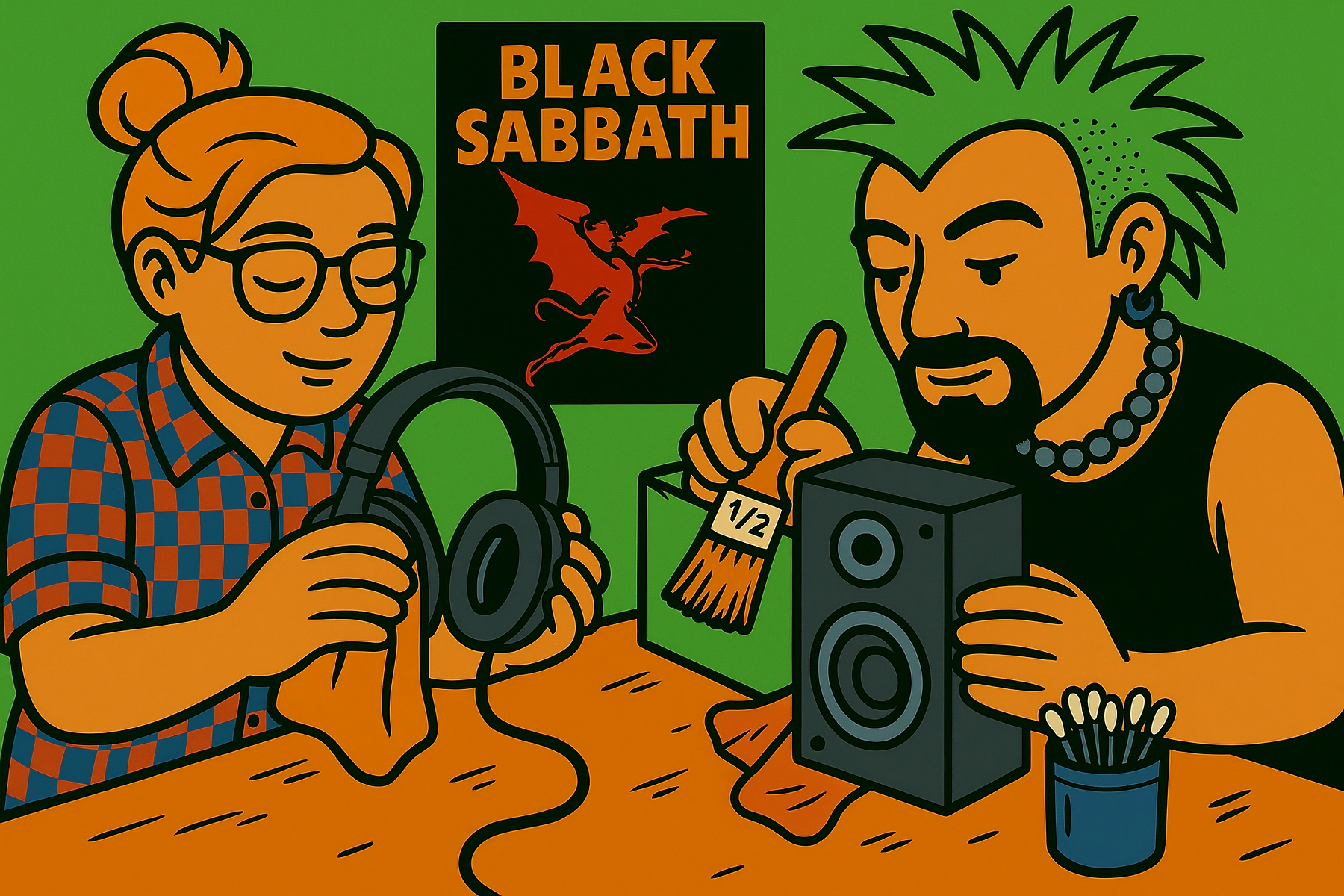One of the aspects I value most about desktop computers is the same reason so many people do without them: they take up a lot of space. That’s a limitation in a society leaning toward tiny apartments and a job market that promotes nomadism in the spectrum of professions that require computers, but for those of us who love PCs it is the opposite: it provides us with advantages and peace of mind. It defines our workspace, allows for more comfortable postures, and gives us room to install things, check the functioning of the components, and easily maintain cleanliness and order.
I understand that for someone who has never opened a CPU case, this might seem like having to repair an engine. But it’s not like that, don’t worry: with today’s information, you will be able to keep your PC in the best condition, without complications or risks –if you keep basic precautions and don’t over-engineer it–. I will give you tasks to do every week and others that are fine to do every two months or every semester. All without special tools.
Let’s start with that and with a clarification: if you are a pro gamer who needs special care for your PC, clearly this guide is not for you. This guide is dedicated to the vast silent majority of people who move the world and make things happen from PCs with budget mouses.
What You Need
Cleaning a PC is not prohibitive at all, although it requires two valuable things: time and space. The first few times, the weekly maintenance routine may take half an hour. But as you gain confidence, you will be able to do it in just a few minutes.
The only essential tool is Phillips screwdriver (the one with the + tip) to disassemble the case, the boards, and the disks. You could even get away with just blowing the dust off, if you really had to. There’s no need to be so sloppy, of course, but also don’t be overly pretentious.
Many guides of this type ask for microfiber cloths and anti-static brushes, compressed air sprays, diluted alcohol in distilled demineralized water, and other nonsense. It would be silly to say they are useless, but the reality is that I have been cleaning my PCs for 25 years usin hardware store paintbrushes, orange cloths, hand pumps, cotton swabs, and tap water, and I have never broken or ruined anything.

Weekly Tasks to Clean and Maintain your PC
Let’s organize this based on the frequency with which you should tackle each step. Unless you are a total slob, there’s nothing that needs to be done daily. Dirt, wear, and tangles are only noticeable after a week or a couple of weeks. So at times when you are free, clear a table, gather the mentioned homemade tools, turn off and unplug the PC.
Clean Your Monitor
Working with a keyboard with some crumbs won’t ruin your hand, but always working with a stained monitor (spring sneeze splatters, stickiness from a Coca-Cola that was too close) strains your eyes and looks terrible. Disconnect the monitor from the outlet and the case, and wipe it with a dry cloth. If you have an anti-static microfiber cloth, great. I use orange cloths, which I try to keep clean. Even a piece of an old t-shirt works. Just make sure it’s not the same cloth you use to dust furniture or clean your boots.
Slightly dampen a clean section of the same cloth and wipe in straight, vertical motions. Don’t wipe in circles and don’t use alcohol or glass cleaner, which often have a base that is too soapy. If a stain doesn’t come out, go over the area with the cloth a bit more damp. Don’t spray the stains with any product or try to scrub them off the screen hard. Train your patience like a spider. Let it dry and use another clean side of the cloth to remove any possible lint.
Clean Your Keyboard
Here you can be a bit rough and the keyboard likes it. Unplug it and turn it upside down. A lot of the dirt will fall out on its own: bread crumbs, hair and lit. For the rest, you will have to give it a few taps on the base of the keyboard. Hey, don’t be afraid: I’ve probably smacked over twenty keyboards like this and never broke one.
With that, the second-order junk should have already been gone, and there will be some greasy dust left, maybe a hair stuck in there. Compressed air is a hassle, it’s expensive. So blow, my friend, blow like there’s no tomorrow, not directly at the keyboard but between the rows of keys. If you have an air pump, even better. If not, buy one: for 3 bucks you save yourself the dizziness from blowing too hard. And if the keys or the structure have gunk, you can use a damp cloth or take off the key and wash it (make sure it’s mega hyper dry before putting it back on).
Clean Your Mouse
For the mouse, you’re going to change tools. Unplug it and remove the dust from its little grooves with a clean brush (the half-inch ones bought at hardware stores cost 2 bucks and are perfect). They’ll tell you that you need an anti-static one. That’s for snobs, don’t pay attention to them, just stay anti-aesthetic. Grab a slightly damp cotton swab and try to remove dust, hair, or dirt from the optical sensor (the red light underneath the mouse). If your mouse has a trackball, clean it the same way. If you cleaned with something damp, even if it was just a measly swab moistened with shower steam, wait for everything to dry before plugging the mouse back in.
On the other hand, that mouse isn’t going to stay clean or move without friction if the mousepad is a grease trap. Depending on the material it’s made of, you can either clean it with a little brush (and some detergent if it’s really greasy), or just wipe it with a damp cloth or simply shake it off.
Clean Your Headphones and Speakers
If you use headphones, unplug them and/or turn them off (depending on whether they are wireless or wired, a true symbol of the low-tech hi-life phylosophy). If they are over-ear ("headband"), use a clean cloth for the rigid parts. If they have pads or foam with some synthetic covering, they may have accumulated sweat or grease. It’s inevitable: you’re not dirty, you’re human. Try to keep them as clean as possible after each use. Clean the grease or sweat from the pads with a dry cloth that doesn’t leave lint and is soft enough not to tear the pad.
If you use in-ear headphones, clean their rubber parts and connectors with a cotton swab slightly moistened in alcohol. Use another one also moistened in isopropyl alcohol to clean the connectors of the charging station, if they are wireless. If they are wired, use a clean cloth slightly moistened in alcohol to clean the cable of greasy gunk. You can do the same with the cables of the monitor, keyboard, and mouse, and with the cables of the speakers.
If you use speakers, you don’t need to clean them thoroughly every week, since they don’t get as much contact as a keyboard or mouse (nor as much grime as a monitor), but it wouldn’t hurt to give them a cloth to remove the dust. Always be careful not to press too hard on the mesh or the speaker cone.
Clean Your Joystick
To clean your joystick, you need to unplug it or disconnect it from Bluetooth and turn it off. Especially to avoid triggering commands with the buttons. Surface cleaning is very simple: a cloth to remove dust, slightly damp if the joystick is very dirty, and the brush in the grooves, joints, and crevices. If there are very dirty areas, like the buttons on the sticks, use the swab with isopropyl alcohol. It’s also important to move the analog sticks while cleaning the base to remove dust from the mechanism and improve the performance of the sensors.

Deep Cleanings to Do a Few Times a Year
Clean Your Speakers
Since we were talking about sound and gaming peripherals, every now and then (a couple of times a year is fine) you need to turn off and unplug the speakers from the PC and wipe them down with a dry cloth on the plastic or wooden part (the "box" of the speaker), but not on the mesh or the cone. If you press against the speaker itself, you could damage it. This is something that, as I already told you, you should do weekly. Now, let’s look at a deeper cleaning. If the grille is removable, take it off and blow inside with the hand pump. First, remove any clumps of hair or lint you can reach with your fingers. Also check the connections (whether they are miniplug or RCA), clean them of possible obstructions (no matter how little lint you see) and clean the jacks (connectors) with a swab with a little alcohol.
Open Your Case and Remove the Worst Dirt
Time to go inside the PC case. Remove the sides (most only remove the one opposite to the motherboard, but take off both). First, inspect how everything is. A photo wouldn’t hurt. Then, remove any dust bunnies you see with your fingers. You can also turn the open case upside down to let them fall, but don’t go slapping it around. If you see a lot of cable chaos, check carefully where each one comes from and where it goes, and try to reorganize them and plug them back in as they were. Zip ties are very helpful for this, but be careful not to crush any cables. A few blasts from the air pump can help you remove the thickest dust. You can use a brush on the metal parts of the case structure to sweep away the dust. By now, your case should be 80–90% cleaner inside.
As for the internal data and power cables, you can remove the dust from the bundles with the brush or a cloth, always trying to ensure that the dirt you remove from each part doesn’t settle back on another part of the PC. You clean each thing and review and remove the waste. At the end of this process, don’t forget to check that all internal cables are secure and in their place (before, you’ll clean their connectors).
Clean Your Coolers
You need to clean the coolers first because they are among the ones that accumulate the most dust and lint. You don’t need to disassemble the coolers from the case or the sides of the case unless they are very stuck or if it’s the first time in a long time that you’ve touched them. You’re going to do this with the PC turned off and unplugged, so you don’t even need to remove them from the internal power supply. Stop the blades with a finger so they don’t spin, and with the clean, dry brush, make the necessary movements to remove the lint, grease, hair, and dirt stuck to the blades. To finish, blow it out with your pump. Never, ever clean the coolers with damp cloths or apply liquid products. Also, don’t even think about using the tip of a screwdriver to pry off gunk: the blades are balanced to spin at a certain angle, and you could misalign them. If you hear noise, vibration, or rubbing when they spin, you’re going to need a new cooler. They’re not expensive and greatly improve air circulation and reduce the noise level of the PC.
Clean Your CPU and Change the Thermal Paste
You’re going to do the same job with the cooler and the heatsinks of the microprocessor, disassembling it first if you can do it easily. If not, don’t stress: some have certain locks that if you force to remove, you could break. If it doesn’t come off easily, don’t get worked up. Removing the cooler mounted on the CPU will give you access to its heatsink and, underneath it, to the CPU itself. If the heatsink is stuck to the CPU, gently turn it side to side before lifting it. When you remove it, you’ll have access to the CPU and see the old dry or hardened paste.
Clean it with a lint-free cloth, slightly moistened with a little isopropyl alcohol. When the surface of the CPU is clean and dry, put a pea-sized amount of new paste in the center. There’s no need to spread it with your finger or with a credit card: when you put the heatsink back on and press it, the paste should spread on its own. Screw it in a cross pattern, little by little, so that the heatsink is level, and therefore, so that the cooler is also level. If this is misaligned, it will not only make noise but you could overheat and eventually burn the CPU. When you’re done, don’t forget to connect the fan cable to the CPU_FAN connector on the motherboard.
Clean Your Boards
When I say "boards", I’m referring generically to the video card (GPU), the motherboard, the memory modules, and, if necessary, to any internal sound card, network card, or something similar. If your case is spacious and organized, you wouldn’t need to disassemble anything. Still, I like to disassemble everything to clean it. At a minimum, unplug the thick bundles of power and data cables (remember where each one goes) and, with the hand pump, blow evenly over the entire motherboard: between the memory modules, between the cables, and around the PCIe connectors. If you see areas where the dust has clumped, use the brush or remove it with your fingers. Reassemble the memory modules and the boards.
The one that may require special care is the video card, which we will definitely need to remove. First, the screw at the back of the case, then check if it has any kind of lock or lever in the PCIe slot, and finally, remove it with a firm pull. Once outside, you’re basically going to repeat what you did with the blowing of the board (like with the motherboard) and the cleaning of the shroud and cooler (like with the CPU). Some boards may have thermal paste between the GPU (equivalent to the CPU) and its heatsink.
Clean Your Ports and Connectors
As you go through this guide, you will constantly be unplugging things. This will give you access to the plugs and sockets of each part of the wiring and circuit board assemblies. Take the opportunity to clean them, because the connectors (USB, HDMI, audio, video, network, power) are contact points where dust, finger grease, and micro-residues can accumulate, causing false contacts or signal loss. Clean them using dry or slightly dampened swabs with isopropyl alcohol. Gently run them along the inner edge of each connector (never too deep) and let them dry a bit before plugging anything back in. Do not use napkins or tissues, as they can leave residual fibers. For audio connectors (miniplug or RCA), it is best to slightly moisten the swab and rotate it inside the jack with gentle movements.
If when reconnecting a cable you notice some looseness or wiggle, that the plug fits loosely, you may need to check the connector, the cable, or even the port. Depending on the degree and nature of the problem, you can buy a new cable and that’s it, or you will have to take the computer to a technician.

